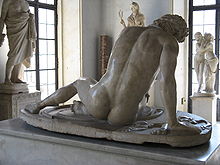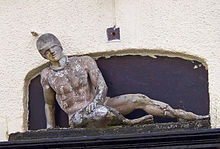- Dying Gaul
-
 The Dying Gaul is a Roman marble copy of a Hellenistic work of the late third century BC. Capitoline Museums, Rome.
The Dying Gaul is a Roman marble copy of a Hellenistic work of the late third century BC. Capitoline Museums, Rome.
The Dying Gaul (in Italian: Galata Morente), formerly known as the Dying Gladiator, is an ancient Roman marble copy of a lost Hellenistic sculpture that is thought[1] to have been executed in bronze, which was commissioned some time between 230 BC and 220 BC by Attalus I of Pergamon to celebrate his victory over the Celtic Galatians in Anatolia. The present base was added after its rediscovery. The identity of the sculptor of the original is unknown, but it has been suggested that Epigonus, the court sculptor of the Attalid dynasty of Pergamon, may have been its sculptor.
The statue depicts a dying Celt with remarkable realism, particularly in the face, and may have been painted.[2] He is represented as a Gallic warrior with a typically Gallic hairstyle and moustache. The figure is nude save for a neck torc. He lies on his fallen shield while his sword and other objects lie beside him.
The statue was most commonly known as the Dying Gladiator until the twentieth century,[3] on the assumption that it depicted a wounded gladiator in the Roman amphitheatre. Scholars had identified it as a Gaul by the mid nineteenth century, but it took many decades for the new label to become the norm.
Contents
Discovery
It is thought to have been rediscovered in the early 17th century during some excavations for the foundations of the Villa Ludovisi and was first recorded in a 1623 inventory of the collections of the powerful Ludovisi family of Rome. The villa was built in the area of the ancient Gardens of Sallust where, when the Ludovisi property was built over in the late nineteenth century, many other antiquities were discovered,[4] most notably the "Ludovisi Throne". By 1633 it was in the Ludovisi Palazzo Grande on the Pincio. Pope Clement XII acquired it for the Capitoline collections. As one of the most famous Roman antiquities, it was then taken by Napoleon's forces under the terms of the Treaty of Tolentino, and displayed with other Italian works of art in the Louvre Museum until 1816, when it was returned to Rome.
Portrayal of Celts
The statue serves both as a reminder of the Celts' defeat, thus demonstrating the might of the people who defeated them, and a memorial to their bravery as worthy adversaries. The statue may also provide evidence to corroborate ancient accounts of the Gallic fighting style – Diodorus Siculus reported that "Some [Gauls] use iron breast-plates in battle, while others fight naked, trusting only in the protection which nature gives."[5] Polybius wrote an evocative account of Gaulish tactics against a Roman army at the Battle of Telamon of 225 BC:
- "The Insubres and the Boii wore trousers and light cloaks, but the Gaesatae, in their love of glory and defiant spirit, had thrown off their garments and taken up their position in front of the whole army naked and wearing nothing but their arms... The appearance of these naked warriors was a terrifying spectacle, for they were all men of splendid physique and in the prime of life."[6]
Livy recorded that the Celts of Asia Minor fought naked and their wounds were plain to see on the whiteness of their bodies.[7] The Greek historian Dionysius of Halicarnassus regarded this as a foolish tactic: "Our enemies fight naked. What injury could their long hair, their fierce looks, their clashing arms do us? These are mere symbols of barbarian boastfulness."[8]
The depiction of this particular Gaul as naked may also have been intended to lend him the dignity of heroic nudity or pathetic nudity. It was not infrequent for Greek warriors to be likewise depicted as heroic nudes, as exemplified by the pedimental sculptures of the Temple of Aphaea at Aegina. The message conveyed by the sculpture, as H. W. Janson comments, is that "they knew how to die, barbarians that they were."[9]
Influence
The Dying Gaul became one of the most celebrated works to have survived from antiquity and was engraved[10] and endlessly copied by artists, for whom it was a classic model for depiction of strong emotion, and by sculptors. It shows signs of having been repaired, with the head seemingly having been broken off at the neck, though it is unclear whether the repairs were carried out in Roman times or after the statue's 17th century rediscovery.[11]
During this period, the statue was widely interpreted as representing a defeated gladiator, rather than a Gallic warrior. Hence it was known as the 'Dying' or 'Wounded Gladiator', 'Roman Gladiator', and 'Murmillo Dying'. It has also been called the 'Dying Trumpeter', because one of the scattered objects lying beside the figure is a horn.
The artistic quality and expressive pathos of the statue aroused great admiration among the educated classes in the 17th and 18th centuries and was a "must-see" sight on the Grand Tour of Europe undertaken by young men of the day. Byron was one such visitor, commemorating the statue in his poem Childe Harold's Pilgrimage:
I see before me the gladiator lie
He leans upon his hand—his manly brow
Consents to death, but conquers agony,
And his drooped head sinks gradually low—
And through his side the last drops, ebbing slow
From the red gash, fall heavy, one by one...[12]It was widely copied, with kings,[13] academics and wealthy landowners[14] commissioning their own reproductions of the Dying Gaul. The less well-off could purchase copies of the statue in miniature for use as ornaments and paperweights. Full-size plaster copies were also studied by art students.
It was requisitioned by Napoleon Bonaparte by terms of the Treaty of Campoformio (1797) during his invasion of Italy and taken in triumph to Paris, where it was put on display. It was returned to Rome in 1815 and is currently on display in the Capitoline Museums.
Copies
Copies of the statue can be seen in the Museum of Classical Archaeology at Cambridge University, Leinster House in Dublin Ireland, as well as in Berlin, Prague, Stockholm, Versaille, Warsaw (Royal Baths Park). In the United States, copies are at the Washington State Historical Society in Tacoma, Washington, and at the Redwood Library, Newport, Rhode Island. The Royal Academy in London had one such copy, now at the Courtauld Gallery in London. It also had an écorché in this pose, cast in the late 18th century from the body of an executed smuggler and hence nicknamed "Smugglerius". In the English market town of Brigg in Lincolnshire, the long established coaching inn The Dying Gladiator displays a copy, using the old title. The College of Fine Arts in the University of the Philippines Diliman also has a copy, using the old title. There is also a copy at the Hermitage Museum in St Petersburg, Russia.[citation needed]
Notes
- ^ Wolfgang Helbig, Führer durch die öffenlicher Sammlungen Klassischer altertümer in Rom (Tubingen 1963-71) vol. II, pp 240-42.
- ^ Dying Gaul. Virtual Sculpture Gallery. Retrieved on August 08, 2008.
- ^ Henry Beauchamp Walters, The art of the Greeks, The Macmillan company, 1906, p.130 notes that it is still most commonly called that because of the popularity of Byron's description.
- ^ Haskell and Penny 1981:224 provide the history of this sculpture.
- ^ Diodorus in Stephen Allen (Author), Wayne Reynolds (Illustrator), Celtic Warrior: 300 BC – AD 100 (Osprey: 25 April 2001), ISBN 1841761435
- ^ Polybius, Histories II.28
- ^ Livy, History XXII.46 and XXXVIII.21
- ^ Dionysius of Halicarnassus, History of Rome XIV.9
- ^ H. W. Janson, "History of Art: A survey of the major visual arts from the dawn of history to the present day", p. 141. H. N. Abrams, 1977. ISBN 0133892964
- ^ First by François Perrier, Segmenta nobilium signorum et statuarum que temporis dentem invidium evase (Rome and Paris 1638) plate 91 (noted by Haskell and Penny 225 and note 15).
- ^ Kim J. Hartswick, The Gardens of Sallust: a Changing Landscape, p. 107. University of Texas Press, 2004
- ^ Byron, Childe Harold, Canto IV (1818), stanzas 140–141.
- ^ A plaster cast was made for the King of Spain in 1650, and a marble copy by Michel Monnier for Louis XIV remains at Versailles (Haskell and Penny 1981:22).
- ^ A black marble copy for the Duke of Northumberland is in the entrance hall of Syon House, designed by Robert Adam; there are copies in several gardens in England, including Rousham, Oxfordshire (by Peter Scheemakers, 1743, according to Rupert Gunnis, Dictionary of British Sculptors 1660-1851, rev.ed. 1968, s.v. "Scheemakers, Peter") and Wilton House, Wiltshire (Simon Vierpyl, before 1769).
References
- A Dictionary of Celtic Mythology. James McKillop. Oxford University Press, 1998
- Art in the Hellenistic Age, Pollitt, J. J., 1986
- The Bloomsbury Guide to Art, Ed. Shearer West. Bloomsbury Publishing Ltd, 1996
- Hellenistic Sculpture, Smith, R.R.R. London, 1991
- Taste and the Antique, Haskell, F. and N. Penny. New Haven and London, 1981. Cat. no. 44, pp 224ff.
- The Oxford Companion to Western Art. Ed. Hugh Brigstocke. Oxford University Press, 2001
Categories:- 3rd-century BC works
- Pergamene sculpture
- Capitoline Museums collection
- Antiquities acquired by Napoleon
- Ludovisi collection
- Ancient Greek military art
- Marble sculptures
Wikimedia Foundation. 2010.



